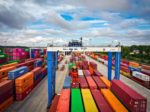Archives
Business, Feature, Freight News, Sea
SC Ports, Inland Ports Benefit ‘Upstate’
[ June 19, 2024 // Gary G Burrows ]South Carolina Ports makes an US$87 billion economic impact in South Carolina each year, and more than half of that economic benefit occurs in the Upstate in the state’s northwest corner, the port authority said.
A recent study by research economist and University of South Carolina professor Joseph Von Nessen found Charleston’s port generates a US$44 billion economic impact in the Upstate each year, with port operations directly and indirectly supporting 132,000 jobs in the region.
“Every time we move a container, it represents real opportunities in our communities,” said Barbara Melvin, president and CEO of SC Ports.
The port’s economic impact in the Upstate has increased 34 percent since the study was last performed in 2019.
“We have seen sustained and substantial economic growth in the Upstate, particularly among port-dependent businesses that are expanding operations and investing in new facilities in the region,” Von Nessen said. “Our state’s economic success is directly linked to SC Ports’ growth as the eighth largest container port in the country.”
In 2013, SC Ports put down roots in the Upstate by opening Inland Port Greer, extending the Port of Charleston’s reach 212 miles inland with dedicated, daily rail service. The direct rail connection to the Port of Charleston enables shippers to speed goods to market.
Inland Port Greer moves goods for advanced manufacturers, mega retailers and consumer goods industries across the Southeast. It has handled more than 156,000 containers so far in the current fiscal year, up 33 percent from the year prior.
To support the growth throughout the Upstate, SC Ports is investing to expand Inland Port Greer with 9,000 feet of new rail and an expanded container yard that can handle 50 percent more cargo.
South Carolina port operations support 260,000 jobs, meaning one in nine jobs in South Carolina are tied directly or indirectly to SC Ports. The full port is available here (https://scspa.com/economic-impact/).
Shippers Benefit
Retailers, manufacturers and agricultural producers benefit from SC Ports’ inland port network, with Inland Port Dillon and Inland Port Greer providing daily dedicated rail service to and from the Port of Charleston.
Besides speeding imports and exports to market, the inland ports reduce overall carbon footprints, ancillary costs and transit times by moving more containers via rail.
Inland Port Dillon set a record for monthly cargo volumes in April, handling 4,730 moves, a 26 percent increase from the year earlier. The facility supports major retailers and agricultural producers in the Pee Dee region and throughout the Carolinas. And with CSX, the operation handles consumer goods, soybeans, forest products, cotton seed and agricultural products.
Inland Port Greer’s record April saw volumes rise 20 percent to 16,105 containers. With Norfolk Southern, the inland port handles goods for advanced manufacturers, mega retailers and consumer goods industries across the region.
Inland Port Greer’s cargo base has diversified since opening in 2013, and many of these companies have invested in the Upstate to take advantage of the inland port. Inland Port Greer is now undergoing an expansion that will double its cargo capacity.
SC Ports’ marine terminals saw container volumes remain steady, with SC Ports and the broader maritime community handling 215,058 TEUs and 119,840 pier containers in April.
The automotive sector saw monthly vehicle volumes rise 40 percent, with 18,118 vehicles handled last month.

Tags: South Carolina Ports







